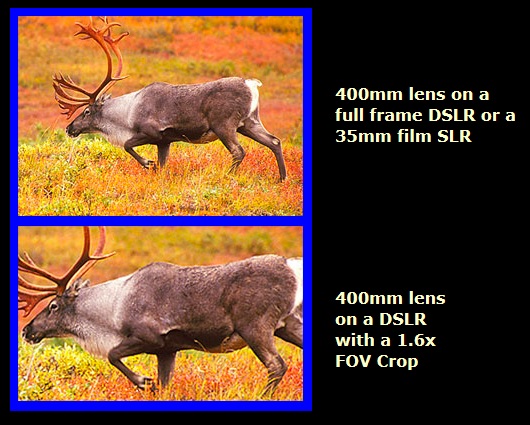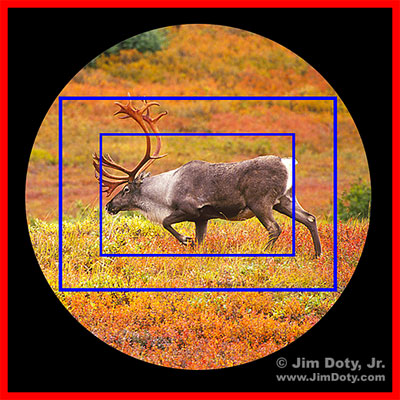The sensors in many digital SLRs (DSLRs) are smaller than a full frame digital sensor which is about the size of 35mm film (24x36mm). When a lens that was originally designed for a full frame digital sensor is put on a cropped sensor camera body, the field of view is different. The image created looks like the focal length of the lens has been magnified so this is sometimes called the “magnification factor”. A 100mm lens on a digital camera with a 1.6x magnification factor produces an image that looks like a 160mm lens on a “full frame” DSLR or 35mm film camera.
In actuality, the focal length of the lens has not been optically magnified at all. The smaller digital sensor just crops more deeply into the image circle that is projected by the lens. It is more accurate to refer to this as a “field of view” (FOV) crop. The field of view crop for many DSLRs ranges from 1.3x to 2x, depending on the camera brand and model.
All lenses project a circular image but the film only “sees” and records part of this image. Film cameras have a rectangular or square window at the film plane so you end up with rectangular or square slides or negatives. Lenses must be designed with a large enough image circle to cover the film format or sensor size. You can’t use most 35mm lenses on a large format camera because the image circle isn’t large enough.
In the illustration at the top, the image circle is being projected by a 400mm lens that is designed to “cover” the sensor of a “full frame” DSLR or the film window of a 35mm camera. The larger blue rectangle represents the full frame DLSR sensor window and the resulting photo.
When you put the same 400mm lens on a DSLR with a field of view crop, the image circle projected by the lens is exactly the same size, BUT the sensor records a smaller area of the image. In the illustration above, the smaller blue rectangle represents a digital sensor with a 1.6x FOV crop. Since the digital sensor records a smaller portion of the same image circle, the caribou looks closer (illustration below). It looks like you took the photo with a 640mm lens.
 All of this is good news for wildlife photographers or anyone else using long lenses since all of their telephoto lenses “act” like they are longer due to the field of view crop. It is like having an instant teleconverter but without any loss of image quality or loss of light. And you don’t have to spend megabucks for a bigger, longer, and heavier lens.
All of this is good news for wildlife photographers or anyone else using long lenses since all of their telephoto lenses “act” like they are longer due to the field of view crop. It is like having an instant teleconverter but without any loss of image quality or loss of light. And you don’t have to spend megabucks for a bigger, longer, and heavier lens.
It is bad news for photographers when they use wide angle lenses because the field of view crop throws away much of the image. A 28mm wide angle lens on a digital SLR with a 1.6X FOV crop has the same field of view as a 45mm lens on a full frame DSLR or 35mm film camera. The wide angle lens now acts like a normal lens. Because of this, manufacturers came out with a variety of wider angle lenses for use on digital cameras. One of the first of these was Canon’s EF-S 10-22mm lenses which will only fit on a cropped sensor camera body.
If you have or will soon get a DSLR with a FOV crop, enjoy the images from your telephotos lenses which have, digitally at least, grown longer. And save your money for one of the new wider angle lenses so you can once again have a truly wide angle field of view.
A lot of professional photographers have a full frame digital camera to make the most of their wide angle lenses, and a cropped sensor digital camera to use with their telephoto lenses. If you have one DSLR and are thinking about getting a second camera as a back up, think about getting the kind of camera you don’t have now, be it full frame or cropped sensor.

